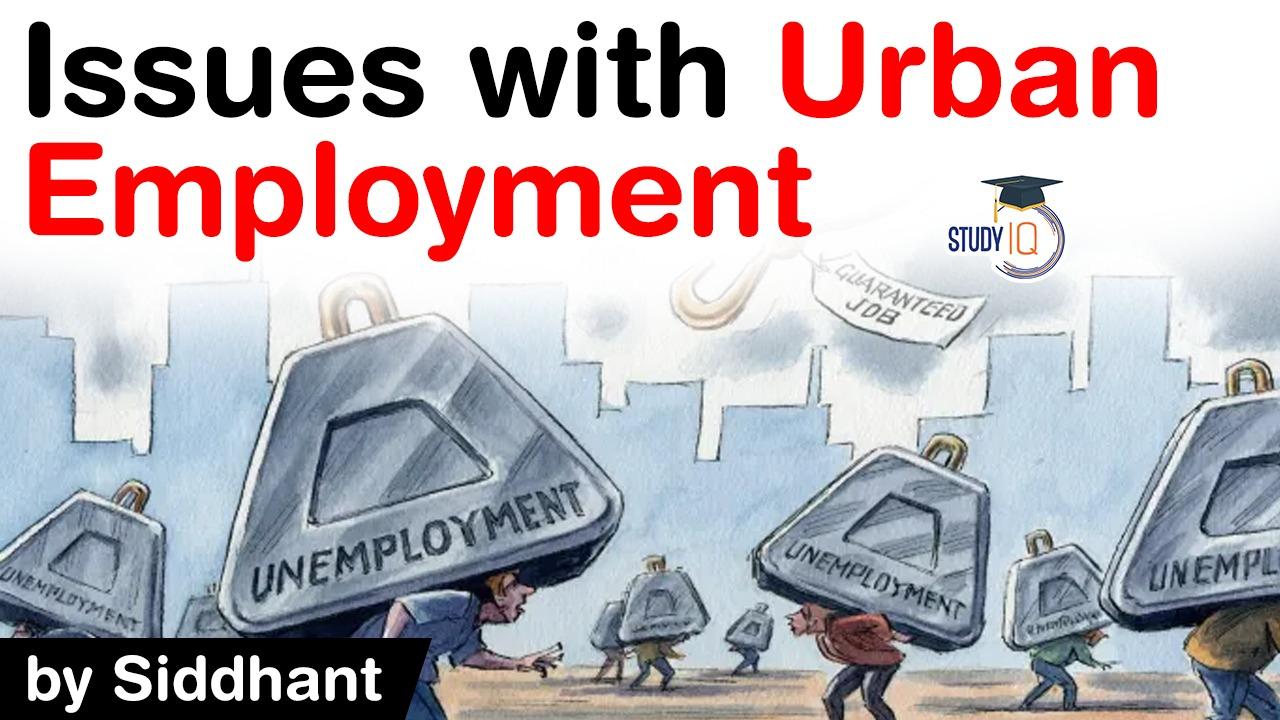Table of Contents
PROBLEMS
- The contraction of the economy raises concern on the employment situation as the shrinking sectors are those that create the maximum new jobs. While the ‘Garib Kalyan Rojgar Abhiyaan’ launched in June (aimed to provide livelihood opportunities in rural India) could be an immediate relief, the Rrs.50,000-crore employment scheme cannot be a substitute for decent urban jobs.
- Given the structure of the economy and demographic profile, it is important to focus on reducing the vulnerabilities of urban informal jobs in the long run.
ECONOMY AND EMPLOYMENT
- In a scenario where each of these sectors is contracting so sharply, it would lead to either a growing number of people losing jobs or failing to get one, or even both. That is, there is a possibility of a decline in employment and a subsequent rise in unemployment.
- This sharp contraction has to be seen in the light of India having witnessed a wave of massive ‘reverse migration’ during the early phase of the lockdown, with millions of workers returning to their home States due to a loss of livelihoods.
ECONOMY AND EMPLOYMENT
- The abrupt announcement of the lockdown exposed the severe vulnerabilities of urban low-end informal jobs as the share of vulnerable employment is higher in India than that of the world or the South Asia region.
- Vulnerable employment is characterised by inadequate earnings, low productivity and difficult conditions of work that undermine the basic rights of workers. They are more likely to be informally employed and lack effective representation by trade unions. According to the International Labour Organization, of the 535 million labour force in India in 2019, some 398.6 million will have poor quality jobs
Situation in India
- The high and persistent incidence of vulnerable employment are a reflection of the nature of the structural transformation process, whereby capital and labour transfer from low to higher value-added sectors. India presents a curious case in this regard as capital and labour are moving from low value-added activities in a sector to another sector, but not to higher value-added activities.
- This leads to a situation where a large proportion of the jobs being created is of poor quality (and is expected to remain so).
Situation in India
- The service sector-led growth in recent years has intensified this as there is coexistence of strong job creation in some Information and Communication Technology (ICT)-intensive services, along with a significant portion of the jobs being created in ‘traditional low value-added services, where informality and vulnerable forms of employment are dominant.
- The outcome of such a process is the high incidence of informality which continues to undermine the prospects of reducing working poverty’. The pandemic and associated policy responses have exposed the vulnerability of these urban jobs.
Steps to take
- The present crisis calls for a multi-pronged strategy to tackle the issue of urban jobs. First, given the scale of urbanisation, the focus on urban employment generation programmes should be in coordination with local governments; this is key to ‘solving other problems faced by cities.
- As these problems are daunting, actors at the local level need to have more resources at their disposal. Resource mobilisation could be enabled by the formation of local alliances, involving elected representatives, trade unions, entrepreneurs and community groups’.
Steps to take
- Second, a major local initiative would be to design and implement employment-intensive investment policies. These policies should embrace the initiatives of both private entrepreneurs as well as by the government. Private investments need to be facilitated by conducive contractual relations between labour and capital.
- Enterprise formation needs to be an integral part of the strategy, with converging interests for workers and entrepreneurs on issues related to technology and productivity enhancement. Small and micro enterprises, the fulcrum of industrialisation, need extra support to balance the interests between labour and capital as neither have collective bargaining powers. The third element, would be to prioritise urban infrastructure as it accounts for a large share of total investments in the local economy.
Invest in infrastructure
- However, much of these investments rarely benefit ‘poor urban dwellers as housing, roads, sewerage and water systems are inadequate for their needs.
- A labour-intensive approach to building municipal infrastructure can be a cost-effective alternative to capital intensive-approach as wage rates are low. Infrastructure investments would spur employment, generate earnings and contribute to small enterprise formation. Construction of low-cost housing is another activity that can be carried out using labour-intensive methods, while yielding substantial collateral benefits for urban dwellers’, as an ILO document establishes.
- The fourth element could be an immediate launch of an urban employment scheme oriented toward building large-scale medical, health and sanitation infrastructure in cities and towns across India.
Only NREGA is not enough
- Further, under the current circumstances it is not valid to assume that the Mahatma Gandhi Employment Guarantee Act (MGNREGA) or its substitutes can absorb a significant proportion of these workers. It is important that MGNREGA be expanded by both increasing the budgetary allocations and the guaranteed minimum number of days of work.
- At the same time, it is very idealistic to conclude that the entirety of the workforce, which has returned to the respective home States, will be accommodated by an expanded MGNREGA or by a close substitute.
Only NREGA is not enough
- These workers might have chosen not to take up MGNREGA jobs in the first place and instead opted to migrate and work in other States for higher wages. MGNREGA and rural jobs schemes have to be strengthened and their capacity increased, but only a portion of the workforce might be accommodated in it.
- There will still be a large number of workers who need to be provided with alternative sources of employment, and generating decent urban jobs looks to be the only way out.
Latest Burning Issues | Free PDF

























 WhatsApp
WhatsApp